Luxor is a city with a rich historical and cultural heritage, and there are numerous ancient sites to explore. Trying to cover all of them in just one day is impossible. Luxor is home to some of the most impressive attractions in Ancient Egypt, such as the Luxor Temple, the Karnak temples, the Valley of the Kings of Egypt, the Temple of Hatshepsut, and the Ramesseum, among many others. On this page, we offer a comprehensive travel guide to help you make the most of your visit to Luxor, which is the heart of modern Egyptology and a must-visit destination for anyone on a Nile cruise.
If you’re looking for a hassle-free trip with every detail taken care of, Egipto Exclusivo is the perfect agency to assist you. We offer a range of services from accommodation to transportation, restaurant reservations, and guided tours to help you make the most of your time in Luxor. Contact us today to start planning your unforgettable journey to Luxor!
Visiting Luxor, like many parts of Egypt, can lead to some confusion of terms. This is partly due to the different languages and alphabets used to name places such as hieroglyphic, hieratic, demotic, Arabic, Greek, Latin, and others. Moreover, the names that the Egyptians gave to their places differ from those given by the Greeks. In the Western world, it is common to use the Greek names, as they are simpler or more familiar.
Furthermore, the variety of tourist destinations of interest in Luxor can sometimes lead to confusion with geographical terms. Therefore, it is essential to have a clear understanding of the following terms:
On this page, we use the name Luxor as it is the current city and the most commonly used term in tourism. However, when referring to the civilization of Ancient Egypt, we will also use the names ‘Thebes’ or ‘ancient Thebes’.
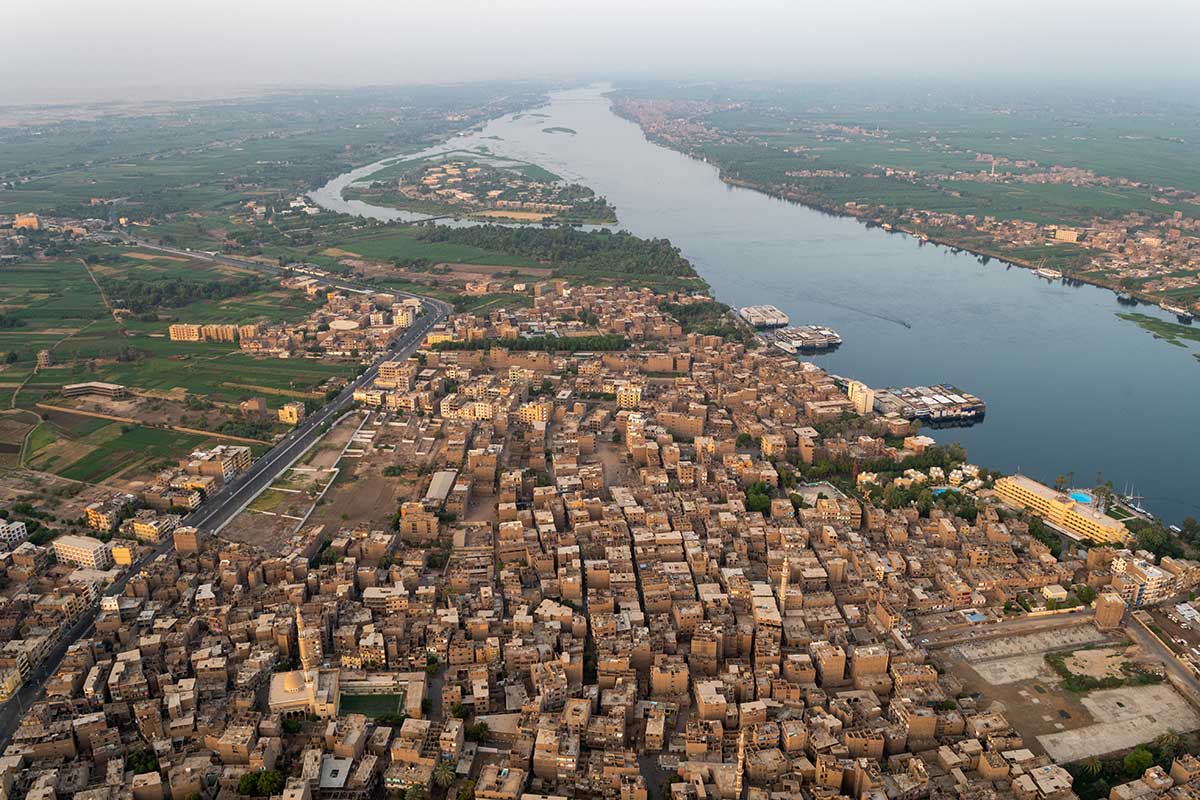
The geographical location of Luxor plays a fundamental role in its climate. Situated in Upper Egypt, approximately 650 km south of Cairo, it takes about 7 and a half hours by car to travel from the Egyptian capital. The city lies on the banks of the Nile, occupying a fertile plain of the river that spans approximately 5 km on each side and in a straight line from the shore.
Beyond this fertile plain lies the arid desert: to the east, the Arabian or Oriental, and to the west, the Libyan or Western. Despite being situated near the Nile, Luxor has a typical desert climate, classified as BWh, similar to the rest of the country. However, the climate is more pronounced here than in other parts of Egypt such as the Delta or the coasts. Here are some of the meteorological values of the city:
For practical purposes, it is important to note that the central hours of the day can be suffocating, especially in summer. If planning a trip during that time, it is recommended to advance activities in the morning or delay them in the afternoon, dedicating the midday to replenishing energy or taking a refreshing dip in the hotel’s pool.
Visiting air-conditioned spaces such as museums in the city or the interior of the Valley of the Kings can also be a good option during the hottest part of the day. The hypogeums of the Valley of the Kings may provide some relief from the heat, although the air inside is not particularly cool, it does provide shelter from the solar radiation, which can be extreme when the sun is high in the sky.
Luxor’s history can be traced back to 2150 BC when it was a small village known for its nomos, which was the cultivable land where it was situated. It was not as significant as the previous capitals like Memphis, Thinis, or Hierakonpolis, and its temples were small and dedicated to local deities like Montu, Mut, and Amun, none of which remain today.
However, from that period, something began to change. The country was divided territorially without a pharaoh exercising common dominion, and the nomarchs of Thebes began to show greater military strength. They progressively subjugated neighboring nomos, expanding their rule to the north and south until they practically conquered all of Egypt.
This was the so-called 11th Dynasty (c. 2150-c. 1990 BC), among which Mentuhotep II, Mentuhotep III, and Mentuhotep IV stood out as the architects of a new reunification of ancient Egypt. This period is known as the Middle Kingdom, and had Thebes as its new capital. Therefore, the city began to grow in size and splendor.
The city of Luxor experienced an even greater boost during the 12th Dynasty, which continued the work of the previous dynasty and initiated some of the most significant constructions still visible today. The Karnak temples, for instance, were started under the rule of pharaohs like Senusret I, who built the White Chapel, now reconstructed using its original stone blocks. This was a time of both quantitative and symbolic growth, with the city’s temples and deities being erected as landmarks for the rest of the region. Amun, in particular, would merge with the sun god Ra to become Amun-Ra and was worshipped at the Karnak complex.
After the fall of the 12th Dynasty, a new period of turmoil and fragmentation emerged, known as the Second Intermediate Period (c. 1750-c. 1550), largely due to the Hyksos invasion. However, the local Theban governors (17th Dynasty), along with their counterparts in other regions of the country, played a crucial role in rearming militarily and expelling the invaders, reuniting the country once more with Thebes as the capital.
As a result, the 18th, 19th, and 20th dynasties during the New Kingdom (c. 1550-1069 BC) saw the city’s greatest splendor. This period witnessed the construction of the main monuments that are visible in Luxor today, such as the Valley of the Kings, the Temple of Hatshepsut, and the Temple of Luxor. The Karnak temples were also significantly expanded, with each new Egyptian military conquest resulting in further growth of the complex as a token of divine gratitude from the pharaohs.
As Thebes grew in size and splendor, the priesthood of Amun also gained significance and power within the city. They became so influential that they even influenced the pharaoh, which ultimately led to the Amarna Period and the reign of Akhenaten (18th Dynasty). This pharaoh attempted to end the priesthood’s privileges, power, and quotas by establishing the monotheistic cult of the solar disk Aten and moving his residence and capital to the new city of Akhetaten, now known as Tell el-Amarna.
However, the polytheistic cult and religious importance of Thebes were restored after Akhenaten’s reign, and the high priests of Amun continued to hold significant power in the city during the first Ramesside Dynasty (19th). Although the capital was later moved to Pi-Ramesses in the Nile Delta, the high priests of Amun remained effective rulers of Thebes, with some even holding the title of pharaoh during the 21st and 22nd dynasties. Despite entering the less splendid Third Intermediate Period (1069-747 BC), the city and its temples were still embellished by the priesthood of Amun and local rulers.
Even during the Persian invasions, Thebes remained a spiritual center until the end of Ancient Egypt. Alexander the Great even visited the city during his stay in the country after his victory over the Assyrians, coinciding with the Opet Festival that was celebrated there. As a result, the Hellenic emperor, crowned as a pharaoh, reconditioned some elements of the Luxor Temple, showcasing the continued importance of the city in both the religious and political realms.
In the same manner as Alexander the Great, the initial rulers of the Ptolemaic dynasty upheld the sanctity of the city’s sacred precincts, which included the Karnak and Luxor temples. Nevertheless, during the Roman and Byzantine periods, the continuity of Egyptian worship was disrupted, causing the city to lose its vitality. In the late 4th century AD, the Luxor Temple was even converted into a Christian church, and some tombs in the Valley of the Kings were used as shelters for Coptic hermits.
Around 640 AD, after the Arab conquest of Egypt, the city and its sacred precincts underwent significant changes. Acknowledging the historical and symbolic significance of ancient Thebes, the Arabs gave it a new name based on the remaining ruins. Hence, the current name, al-Qusur (which means “The Palaces”), refers to the Karnak and Luxor temples. However, despite the new name, the city did not regain its former glory and remained a humble settlement constructed upon the ruins of the once-great Theban capital.
When we say that the city was built upon the ruins of ancient Thebes, we mean it quite literally. The most significant structures of the ancient city were slowly covered by layers of sand that were deposited by the desert winds. This layer of sand almost entirely buried the original structures, fortunately aiding in the preservation of the monuments in excellent condition that can be viewed by visitors today in Luxor.
In any case, the new Arab inhabitants went further and, as can be seen today, occupied part of the Luxor Temple to build the Abou Al Hagag Mosque, in a unique combination of elements from both periods, where minarets and pylons are mixed together. The name of this mosque evokes Sheikh Yusuf Abou Al Hagag (13th century), a sacred figure considered a descendant of Mohammed through his daughter Fatima. Since he was buried here in the 13th century, his mawlid or birthday began to be solemnly commemorated annually.
This religious event was practically the only thing that gave Luxor some recognition for centuries until, thanks to the development of Egyptology in the 19th century, the world once again turned its attention to the ruins of ancient Thebes. This interest also led to the rediscovery of Egypt’s Valley of the Kings, whose treasures were extracted at the time with more of a treasure-hunting zeal than that of conservationist archaeologists.
Egyptology evolved into Egyptomania in the 20th century, especially after the discovery of Tutankhamun’s tomb in 1922. By then, and for the good of the country, new findings were already being added to the collections of Egyptian museums, attracting an increasing number of tourists. Now, Luxor has nothing in common with the city that was losing its heritage at a rapid pace. In fact, since 1979, it has been designated a UNESCO World Heritage Site under the title of “Ancient Thebes with its Necropolis.
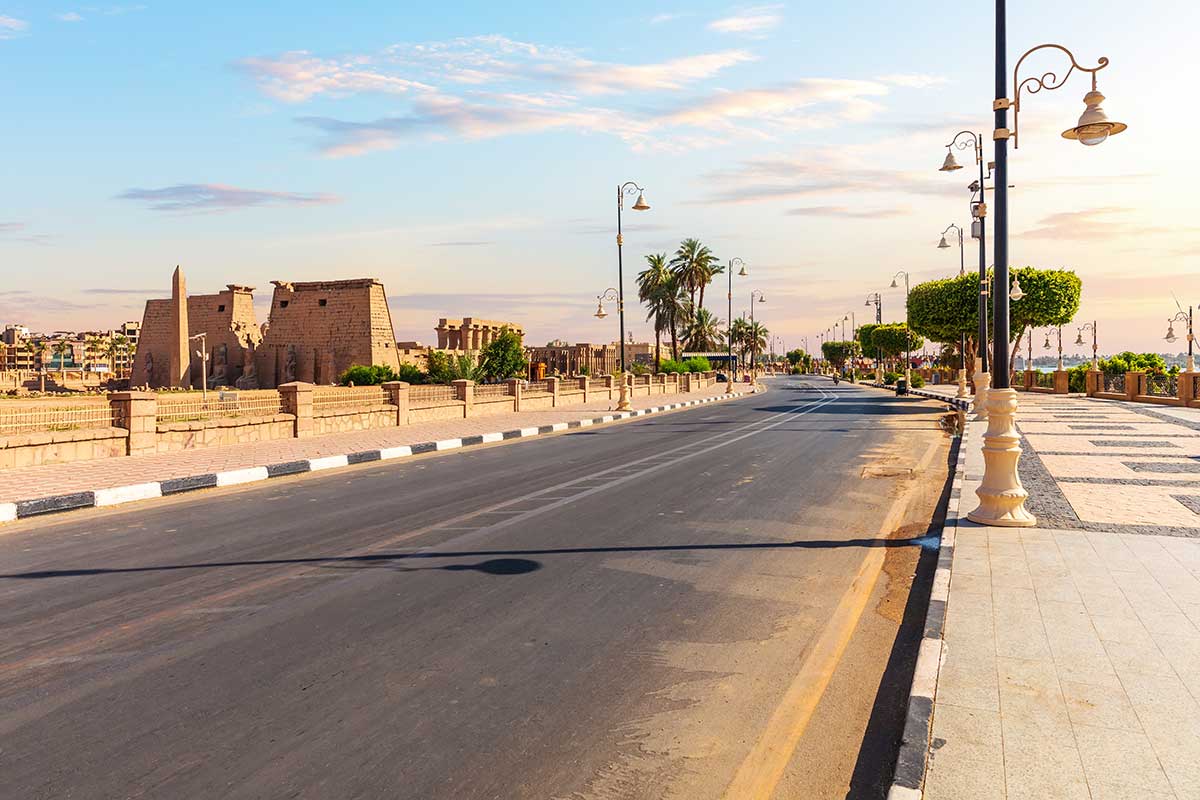
In the present day, Luxor is a city heavily reliant on tourism, with more than three-quarters of its workforce, according to some sources, directly or indirectly employed in this sector. Agriculture, especially the cultivation of sugarcane, is also an important source of livelihood for many locals, who often cultivate plots of land for personal use.
With a population of around half a million people, Luxor has undergone significant urban renewal and service upgrades, fueled by the large influx of tourists. Examples of this can be seen in the recent rehabilitation of the Corniche, a picturesque riverside promenade on the eastern bank of the Nile, as well as the establishment of a new university in 2019.
Due to the political and religious importance that ancient Thebes had, it is easy to imagine that there are many things to see in Luxor. Many. But luckily, they are not excessively far from each other. To make it easier for you to move around the places of interest, we will divide what there is to see in Luxor into two main areas:
The link between both areas is made at the height of the Luxor Temple: there you will find a ferry that, every so often, crosses the Nile from one bank to the other to transport passengers, mainly tourists. In the ‘Practical Information about Luxor’ section, we give you more details.
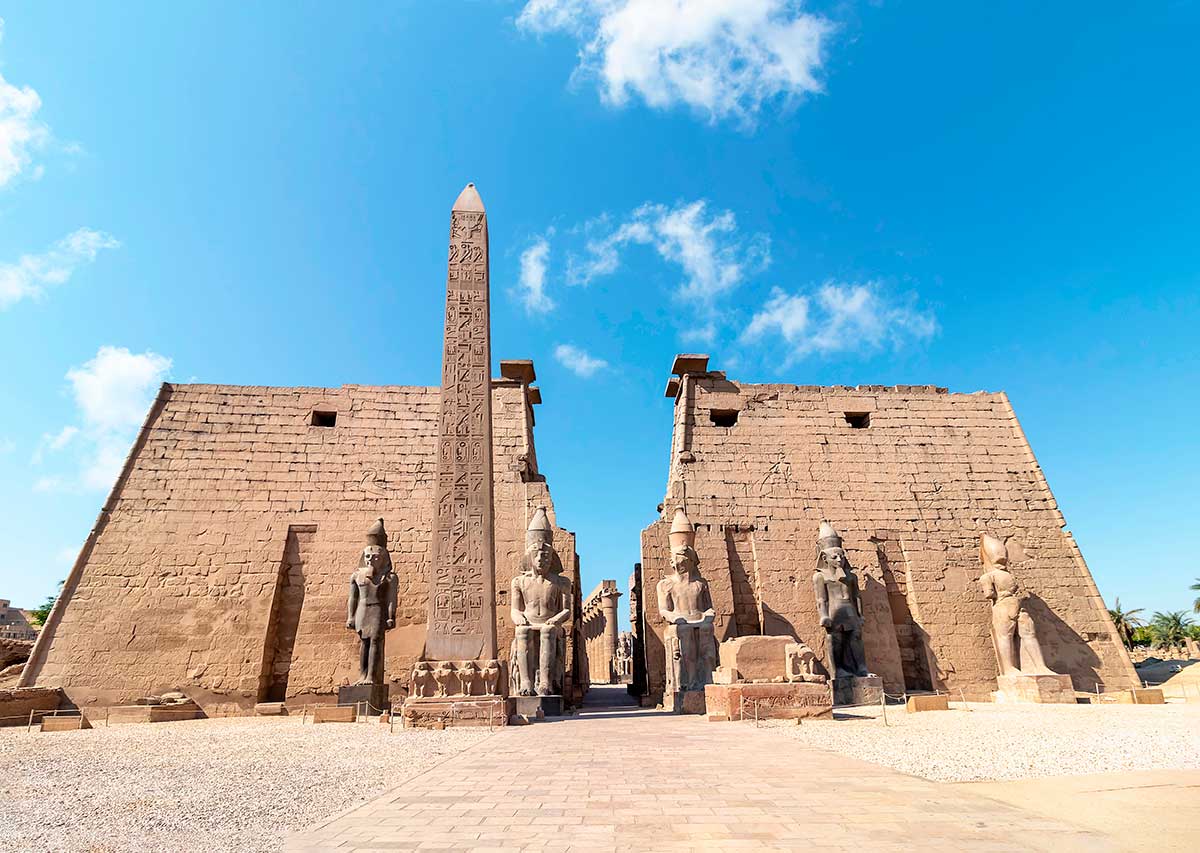
From a tourist’s perspective, the area surrounding Luxor Temple is considered the center of the city, which was once the heart of Ancient Thebes. This area serves as a reference point to explore the great attractions to see in Luxor. Abou Al Hagag square, located a few hundred meters from the train station and near the pier for the ferry to the west bank, is a favorite public space for both tourists and locals. It offers a view of the mosque of the same name and the Luxor Temple.
Your sightseeing program can start with the Luxor Temple, which is not very crowded and can be enjoyed at a leisurely pace. A suggestion is to visit it at night, when the night lighting raises its magnetism and solemnity to the maximum expression.
It was first constructed by Amenhotep III in the 14th century BC during the height of Ancient Egypt’s Theban capital. Over the years, it has undergone several changes and additions. The Memnon Colossi, located on the West Bank, were part of Amenhotep III’s grand funerary temple project.
As you enter the Luxor Temple, you’ll be greeted by the breathtaking Avenue of the Sphinxes. This paved road once connected the Luxor Temple with the Karnak Temples, located about 3 km northward. At one point, the avenue was home to approximately 700 sphinxes! It served as a magnificent route during the Opet Festival, which was held annually to celebrate the flooding of the Nile and the pharaoh’s power. The festival involved transporting portable images of the local triad, Amun-Ra, Mut, and Khonsu, in boats. Today, the festival is reenacted with hundreds of participants dressed in traditional clothing, making it an interesting spectacle to witness if your visit coincides with it.
As you pass through the remaining sphinxes, you’ll reach the first pylon of the Luxor Temple. This was built during the reign of Ramses II and engraved with the Battle of Kadesh against the Hittite Empire in 1274 BC. Ramses II was incredibly proud of this battle, as evidenced by Abu Simbel. He also commissioned the construction of six colossal statues of himself and two obelisks, although only two sitting statues and an obelisk remain today (the other obelisk stands in Place de la Concorde in Paris).
Beyond the first pylon is the Great Court of Ramses II, another of his ambitious constructions, featuring rows of columns with papyrus-shaped capitals. Additionally, there is a space dedicated to the Boat Sanctuary. Interestingly, the Abou Al Hagag mosque is embedded here, and due to the local people’s devotion to this sacred personage, it was decided to remain in its current location after the archaeological works. This decision has enabled the Luxor Temple to maintain a religious cult for over 3,000 years without interruption, which is quite an impressive feat!
After passing through the expansive courtyard, the Luxor Temple returns to its origins with spaces that were primarily conceived during the reign of Amenhotep III. Visitors are left awestruck by the processional colonnade, with columns that soar over 20 meters in height, likely serving as inspiration for the hypostyle hall of Karnak. The Sun Court, flanked by rows of columns on three sides, leads to the hypostyle hall and the interior and roofed sanctuaries.
Aside from chambers and sanctuaries, there is also another space for the boat, and the ‘sancta sanctorum’ is preserved, a space that only the pharaoh and priest could access, which housed the image of Amun-Ra, now lost. Additionally, remnants left by the Roman camp established here during their occupation can be observed.
After exploring this magnificent temple, you can venture to the other great sacred enclosure to visit in Luxor: the Karnak temples. While in ancient Thebes, the journey could be made along the Avenue of the Sphinxes, today there are several streets that break this continuity. Instead, it is common to head northwards along the Corniche, the eastern bank of the Nile, which is a pleasant walk that offers views of the Western Bank and access to other places of interest, such as the Luxor Museum or the Mummification Museum (see the ‘Museums to see in Luxor’ section).
If you don’t stop at any of the charming cafes along the riverbank, you’ll eventually reach the Karnak temple complex after a long walk. Before making the journey, consider your strength, available time, and the time of day you are traveling. If any of these factors are not favorable, you may want to take a taxi or carriage (see the ‘Practical information about Luxor’ section below). Alternatively, a nighttime visit during the light and sound shows can be a fascinating experience.
Describing the magnificence of the Karnak temples proves challenging, even in their present state of decay and lack of religious function. The complex was given the name “ipet-isut” by the Egyptians themselves, meaning “the most perfect place.” The project was initiated by the pharaohs of the Middle Empire, who hailed from Thebes and reunified the country from this city. The most significant of the Karnak temples was built during the New Empire (c.1550-1069 BCE), with contributions from the Ptolemaic dynasty and the Roman domination, resulting in nearly 1,500 years of continuous construction, with numerous additions and modifications.
The Karnak temples served as more than a sacred space; they were an administrative center, the residence of the pharaohs, and, during their construction periods, a place where thousands of workers labored. The temples were also the seat of the clergy of Amun, whose priests wielded so much influence that some of them adopted the title of pharaoh during the Third Intermediate Period (1069-747 BCE).
The Karnak temples comprise three enclosures, namely the Amun, Montu, and Mut enclosures. The Amun enclosure is the largest, most famous, and spectacular one, serving as the central precinct that connects to the other two, smaller and in worse condition, although they are still worth a visit. In total, the site covers an area of about 30 hectares, making it enormous. Thus, discovering the Karnak temples thoroughly, like the other great monuments to see in Luxor, requires patience.
As you arrive at the Karnak temples, the entrance and visitor reception center are located adjacent to the Nile. Upon entering, you will immediately come across the short Avenue of the Ram-Headed Sphinxes, which in the past was accessed through a channel diverted from the river where sacred boats navigated. The first pylon stands here, which, although unfinished, once welcomed visitors with impressive flags. You can tell it is unfinished because of the unequal height of its walls.
As you continue exploring, the Great Court comes next, which houses the small temple of Seti II and chapels for the Theban triad boats, as well as the temple of Ramses III. You’ll also spot a colossal statue of Ramses II, an important figure in the construction of the Karnak temples. It’s actually older than him but has been retouched to look like him.
Moving on, you’ll come across a second pylon, and then you’ll arrive at the most emblematic and photographed space, the Great Hypostyle Hall. Often referred to as a “forest of columns,” it’s more accurate to describe it as a “sea of columns” since it likely represents the primordial ocean of Egyptian religion, with papyrus plants growing as indicated by the capitals that adopt that form. The sheer number of columns is impressive – 134 in total, ranging from 15 meters to 21 meters in height, with a circumference of about 10 meters. The columns are intricately carved and, at one time, were polychromed, making visitors feel small in their presence.
After the Great Hypostyle Hall, you’ll cross a third pylon from the time of Amenhotep III and reach a courtyard before reaching the oldest part of the precinct from the time of Thutmose I (15th century BCE). Past the fourth pylon, you’ll see the obelisk of Hatshepsut, the tallest in Egypt at about 30 meters, although there were other obelisks on the site in the past.
Beyond this point, the structures become more decayed, making it challenging to discern the purpose of each area, although a cubic construction served as a sanctuary for the Sacred Boat is still recognizable. Additionally, the Sacred Lake, which previously supplied water to the Karnak temple complex, is easily distinguishable.
The described elements follow a west-east axis, but another north-south axis connects the two other Karnak temples, Mut and Montu, which are located outside the Amun precinct and feature several pylons. The Mut temple, dedicated to Amun’s wife, has suffered the most significant deterioration, while the Montu temple, dedicated to the god of war, is not always open to visitors.
Among the temples in Karnak is the Temple of Khonsu, accessed via the Avenue of Sphinxes that originates from the Temple of Luxor. The Temple of Ptah is relatively small and was added during the reign of Thutmose III, promoting devotion to the creator god whose cult center was Memphis. Furthermore, the northern section of the Amun precinct houses an open-air museum that showcases the White Chapel from the time of Senusret I (12th Dynasty, Middle Kingdom, 20th century BC). It was reconstructed using many of its original stone blocks, which were previously scattered throughout other parts of the precinct.
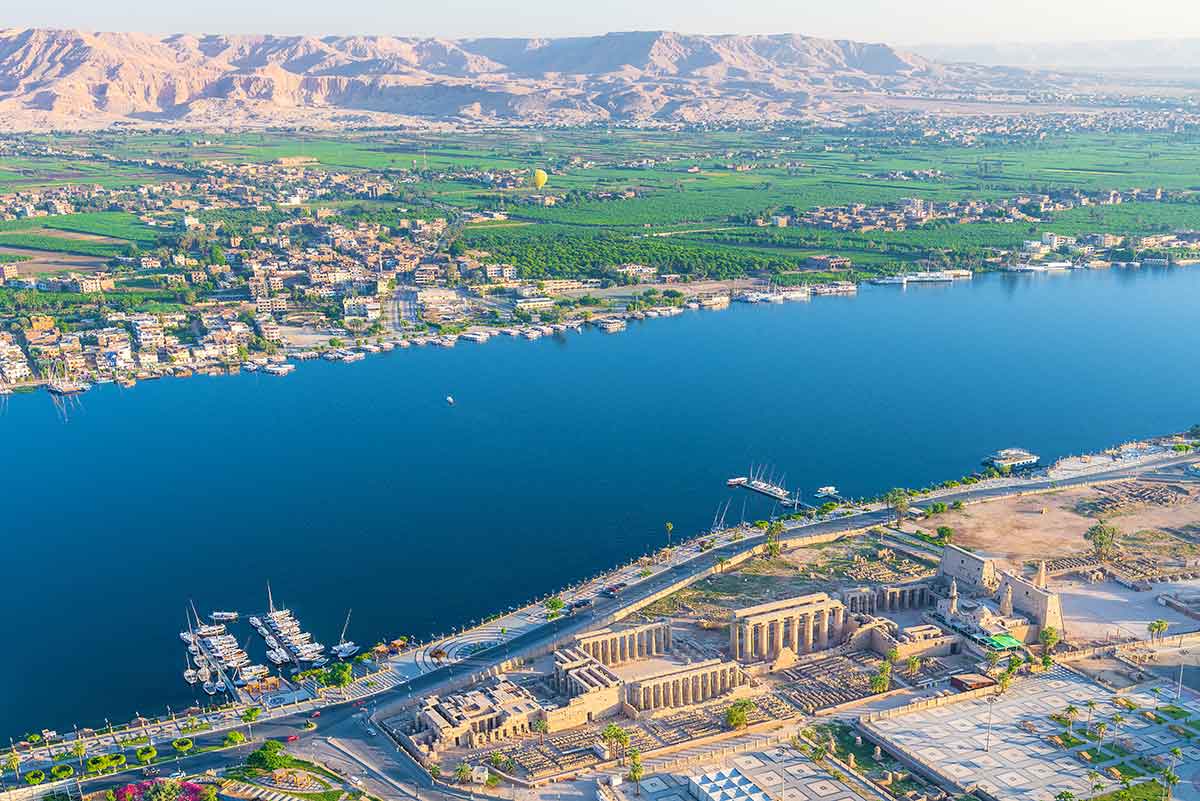
The West Bank of Luxor is home to many must-see attractions, and it covers a vast area that would take more than a day to explore in detail. You can get there by ferry, which crosses the Nile every 10 minutes from the pier next to the Temple of Luxor. Once you leave the area with shops, restaurants, and hotels, you will find a large road that leads to the visitable area, situated between rugged elevations that emerge once the green fields of crops end.
Since the midday heat can be unbearable, we have two tips for you. First, prepare yourself mentally to wake up early as you can visit the monuments during the early hours of the morning when the temperature is more pleasant. Secondly, choose your means of transportation wisely to get around, with a private taxi being the best option. Walking is not recommended due to the long distances and harsh weather conditions.
As mentioned earlier, many of the must-visit places in Luxor are on the West Bank, and we will guide you through them one by one below.
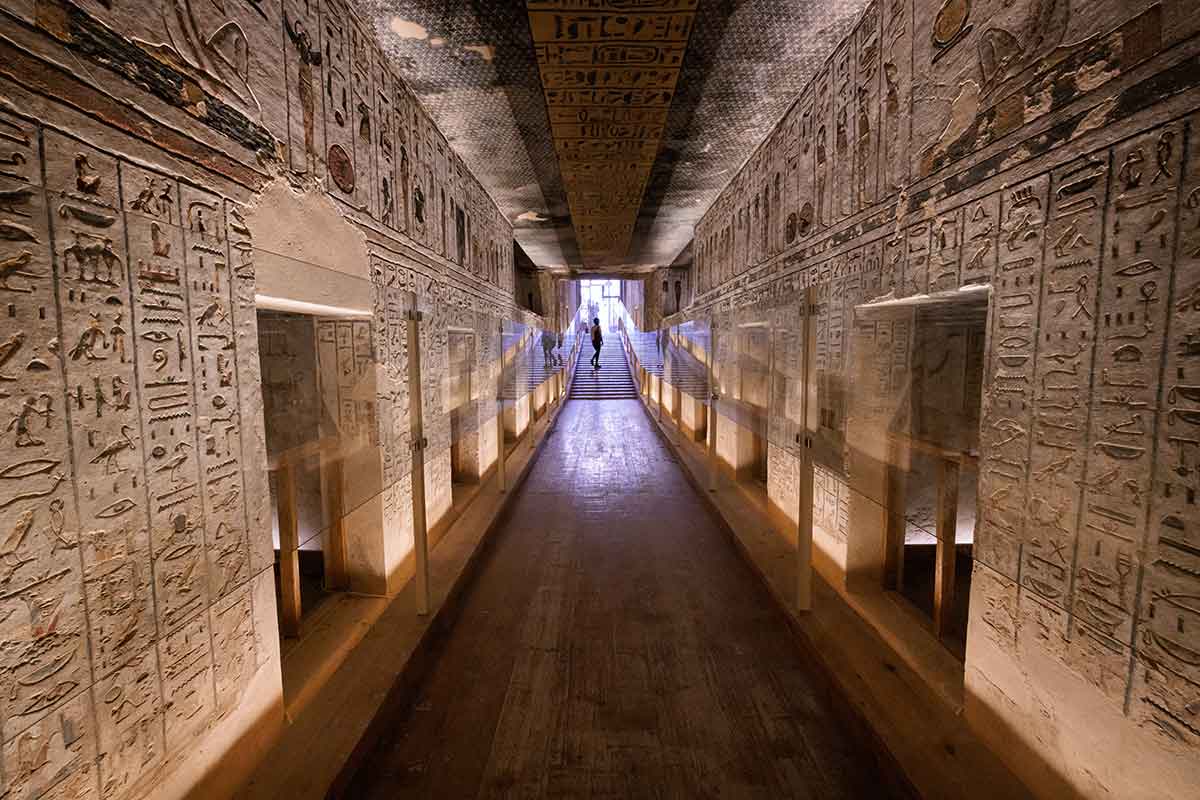
The Valley of the Kings, alongside the Luxor Temple and Karnak Temples, played a pivotal role in establishing ancient Thebes as a grand city during its time. It served as the pharaohs’ necropolis from the 18th dynasty onwards, offering a secure and sheltered place for their eternal rest. The pharaohs could supervise the construction from the capital, thus ensuring that their tombs met their requirements. However, despite the remote and inaccessible location of the Valley of the Kings, many tombs were looted by raiders and thieves, leading to a significant loss of heritage. Nonetheless, Luxor and its museums still display numerous objects from these tombs, as do other cities, including Cairo and foreign ones.
The Valley of the Kings, like other necropolises in the region and Ancient Egypt, is situated on the west bank of the Nile, where the sun sets. The Egyptian religion believed that the Duat, a celestial underworld, was located there. Ra, the god of the sun, traveled through it with his boat towards the dawn, thus making an underground west-east journey that he later replicated in the sky.
For these reasons, most pharaohs of the New Kingdom considered the Valley of the Kings the appropriate location for their eternal rest. They excavated rock hypogea of great complexity and decorative richness, featuring engravings and paintings from floor to ceiling and a funerary equipment deserving the name “treasure.” The construction of these tombs took many years and required significant economic and human resources.
The Valley of the Kings in Egypt underwent construction and expansion for approximately five centuries, from the 16th to the 11th century BC. Over 60 tombs have been discovered, with sizes ranging from simple pits to enormous hypogea with over 100 chambers. However, there are still several significant pharaohs’ tombs that remain undiscovered, which continues to motivate researchers in their quest. To distinguish and identify the tombs, they are numbered as follows:
There are no two identical tombs in the Valley of the Kings, but we can indicate some common characteristics to many of them:
Fortunately, for tourists today, many of the tombs are open to visit, and we’ve highlighted some of the most beautiful and significant ones that you can add to your list of places to see in Luxor.
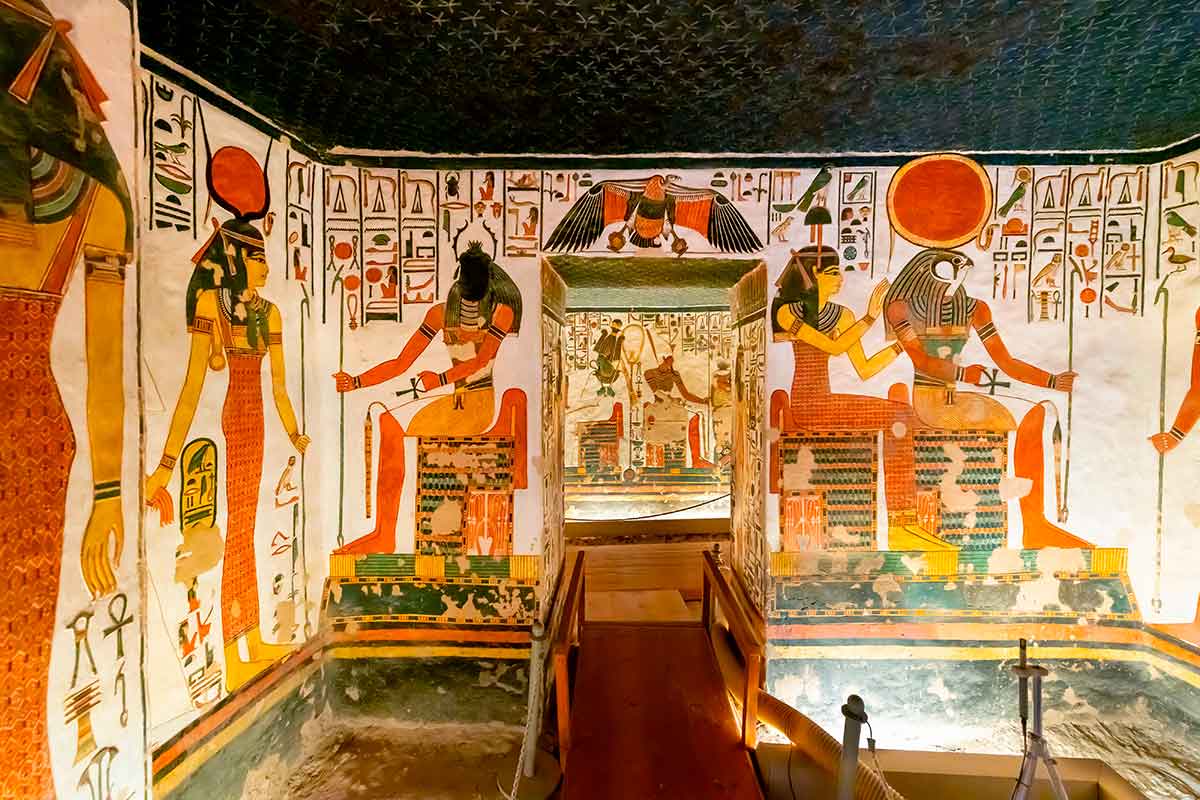
The Valley of the Queens, located in the southern area of the Theban necropolis, follows the same typology as the Valley of the Kings. It is a valley without a watercourse intended for the rest of royal wives, princesses, princes, and other important members of the court. While more than 70 tombs are present, not all of them are visitable. Nonetheless, they are worth adding to your list of things to see in Luxor. The tombs are numbered according to the same criteria: QV (Queens Valley) and a number. Some of the noteworthy tombs are:
The tombs of kings, queens, and princes are not the only things to see in Luxor: on the West Bank, there are also others dedicated to the nobles or local rulers who did not want to miss the opportunity to be buried with all the honors. The so-called Tombs of the Nobles are located near the Ramesseum and are embedded in the rock like bunkers. Hundreds are counted, although only a few are visitable. Some of them have truly rich decoration. One of the most interesting aspects is that, unlike the iconographic programs of the pharaohs and queens, here, more specific details about the daily life of Egyptian civilization, as it was more than 3,000 years ago, can be learned.
Luxor is not just about the tombs of the royals. The West Bank also houses the Tombs of the Nobles, dedicated to the local rulers and nobles who wanted to be buried with honor. These tombs are located near the Ramesseum and are embedded in the rock. Although hundreds exist, only a few are open to visitors. What makes these tombs unique is their depiction of specific details about the daily life of the ancient Egyptian civilization over 3,000 years ago.
If you still have the energy to explore, here are some noteworthy tombs to consider adding to your list:
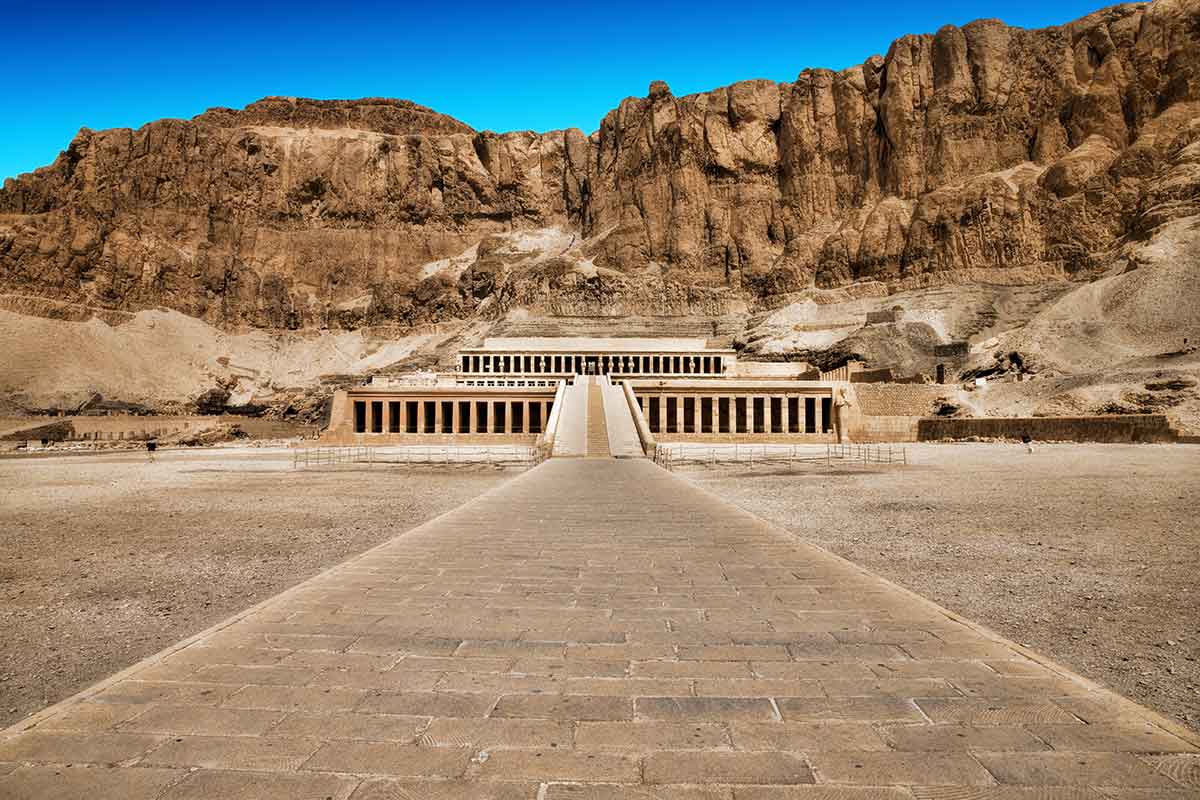
Luxor’s West Bank offers much more than just tombs to explore, with temples of significant religious and symbolic value such as Deir el-Bahari. This sacred enclosure is a must-visit destination for anyone in Luxor. It’s so popular that it’s not just a stop on bus tours but also a highlight of balloon rides thanks to its unique location at the foot of towering cliffs.
Deir el-Bahari consists of three funerary temples, including those of Mentuhotep II, Tutmosis III (located further away next to the fields), and Hatshepsut. The name Deir el-Bahari originally referred to a Coptic monastery and cemetery that once stood here. The oldest of the three temples, that of Mentuhotep II, was oriented towards the east, likely as a sign of worship to the sun god Ra. Mentuhotep II was a key pharaoh in the beginnings of the Middle Kingdom, which was the first period of splendor of ancient Thebes. The most recent of the three temples, that of Tutmosis III, was probably abandoned after a significant collapse during the XX dynasty. Little remains of either temple, with only small remnants that are difficult to move.
The temple of Hatshepsut is undoubtedly the most well-known, although its state of preservation is less than ideal, but it’s not due to looters or natural disasters. The blame falls on her son, Tutmosis III. Hatshepsut was the daughter of Tutmosis I and married her stepbrother Tutmosis II, with whom she had Tutmosis III. When Tutmosis II died prematurely, Hatshepsut took over as regent and, with the support of the Amun priesthood, became queen-pharaoh. She adopted masculine characteristics and commissioned the construction of a grand temple, which she named Djser-Djeseru (Sacred of the Sacred), giving it great solemnity. Tutmosis III contested her claim to the throne and succeeded her upon her death, leading to speculation that he may have played a role in her demise.
It’s evident that Tutmosis III was bent on destroying his mother’s temple. The present appearance of the temple is largely the result of a controversial restoration, particularly in terms of its symmetry, carried out in the mid-20th century by an Egyptian-Polish team of experts. Regardless, the temple was a one-of-a-kind structure, constructed on terraces and featuring elements that were precursors to Greek and hence Western architecture, such as the proto-doric columns of the chapel of Anubis. Among the remaining features, the decorative reliefs and the capitals of the columns of the chapel of Hathor are notable.
There are many other fascinating sites scattered throughout the West Bank. Luxor, being the political and spiritual capital of Ancient Egypt for much of its history, boasts numerous monuments closely linked to various pharaohs. For instance, Amenhotep III of the 18th dynasty commissioned the construction of a massive temple on the west bank of the Nile, one of the largest of its time, featuring two colossal statues of himself at the entrance, along with smaller statues of his wife, Tiyi, and mother, Mutemuia. Today, these statues, known as the Colossi of Memnon, are all that remains of the temple and were named after the Greek hero Memnon, who they believed was saluting his mother, the goddess of dawn, Eos, every morning.
On your way to the Valley of the Kings, if you take the Al Tmsalyn road, you will encounter the Colossi of Memnon. Shortly after, you will come across the Ramesseum, a funerary complex commissioned by the great Ramses II. The complex included smaller temples dedicated to his mother Tuya and his favorite wife, Nefertari, as well as palaces, storehouses, and other dependencies. Although only a small portion of it remains standing, its most famous features are still intact, such as the colossi representing Ramses II in the form of a mummy and in the Osirian position. However, most of the heads and busts are now scattered on the ground or housed in museums around the world. The Ramesseum had several pylons and courtyards, as well as a hypostyle hall with enormous columns featuring polychrome and papiform capitals, still visible today. One of the most unique rooms is the astronomical hall, featuring a ceiling adorned with a calendar based on constellations. Later, the complex was repurposed as a Christian church by the Copts.
The West Bank is home to many other fascinating places to explore beyond the Valley of the Kings. One such site worth visiting is the temple of Medinet Habu, built by Ramses III and modeled after his predecessor’s Ramesseum. The temple’s name is subject to debate, but it may reference a royal scribe named Hapu. This walled complex, resembling a city, served as an administrative center and sanctuary for the people of Thebes during times of conflict. Medinet Habu features temples, chapels, royal residences, and accommodation for officials and priests. It was even repurposed as a Coptic village with a church before being abandoned in the 9th century AD. The polychromatic decorations preserved in parts of the temple give us a glimpse into its former glory and that of other contemporaneous structures.
Further north on the West Bank lies the often-overlooked temple of Seti I, though it is a significant monument of the New Kingdom’s 19th dynasty. Seti I’s reign saw the revival of the country’s power after the turbulent Amarna Period, setting the stage for his son Ramses II to establish Egypt’s dominance in the region. The temple, which served as a funerary complex for Seti I, is located near the road leading to the Valley of the Kings. Although it has suffered from the effects of time, the portico with papiform capital columns and the hypostyle hall that evokes that of Karnak, which Seti I himself promoted, are still mostly intact. The temple’s reliefs are exquisite examples of Ancient Egyptian art and deserve a visit. However, with so many other remarkable monuments to see in Luxor, it can be challenging to fit it into your itinerary.
Undoubtedly, the impressive monuments of Luxor, including Medinet Habu, the Ramesseum, and the temple of Seti I, were built by skilled workers and craftsmen who toiled tirelessly in the region. Fortunately, a part of their living quarters still exists and is preserved in the vicinity of these complexes at Deir el-Medina, although only the foundations of their homes remain standing. Nonetheless, it serves as a fascinating source of knowledge regarding daily life in ancient Egypt, which researchers have been able to interpret through archaeological research. The food remnants found here have provided insights into their diet, which predominantly consisted of fish and cereals, accompanied by some fruit, honey, and occasionally, meat. Interestingly, these food items also served as their primary currency for payment in kind. Additionally, their small necropolis reveals that the humble mortuary chambers were adorned with tiny pyramids.
Apart from Medinet Habu, there are other places in Luxor with significant ethnographic value, such as Gurna (or Gournah) and the Howard Carter House, which have vast differences between them. Gurna is a village where a few inhabitants still reside, located near the Tombs of the Nobles. Its modest houses add a splash of color to the arid valley. Historically, the village was notorious for plundering nearby treasures, but nowadays, it benefits from tourism in a much more legal way. The villagers are artisans, traditional bakers, farmers, and other simple professionals.
The Howard Carter House, on the other hand, was the home of one of the most renowned archaeologists of all time. Carter’s unwavering faith in the discovery of an intact tomb was realized when he discovered the tomb of Tutankhamun. The residence is well-preserved and provides a glimpse into the life of this British researcher from the early 20th century. For those who are passionate about Egyptology and its history, it is a must-visit place in Luxor.
Luxor is home to several museums that showcase invaluable exhibits, many of which originate from nearby monuments. These include the Temple of Luxor, the temples of Karnak, and the entire West Bank, which encompasses the Valley of the Kings. Thanks to their air conditioning and internal elements designed to help visitors understand their historical context, they are great options to explore during the hottest parts of the day.
The Luxor Museum is not only the most important museum in the city, but also one of the most fascinating in the country. Its modern structure allows for a more organized display of the exhibits, which are relatively fewer in number compared to the Egyptian Museum in Cairo. The museum also features audiovisual content in some of its rooms, making the visit more engaging. Some of the most interesting exhibits on display include:
Contrary to what its name suggests, the Museum of Mummification does not display excessive mummies, nor does it focus on the most gruesome details of this post-mortem process. Instead, the museum offers a fascinating glimpse into the art and science of preserving the body of the deceased, an essential practice for achieving eternal life in the afterlife. The most significant exhibit is the mummy of Masaharti, the high priest of Amun-Ra during the 21st dynasty, which is remarkably well-preserved, even retaining its hair and beard.
The museum also houses other intriguing artifacts, such as mummified animals, including cats and baboons, and the tools used to extract the brain or viscera from the deceased’s body. Although you can explore the museum’s entire collection in about an hour, we recommend visiting the cafeteria for stunning views of the Nile River while enjoying a refreshing drink.
Now that you have an idea of what to see in Luxor, here’s some practical information to help you plan your trip and make the most of your stay in this ancient city. We cover transportation options, how to get around, and where you can find additional resources and information during your visit. If you want a hassle-free experience, consider contacting Egipto Exclusivo, a professional agency that can provide private transportation, accommodations, and expert guides to ensure you don’t miss any of Luxor’s wonders.
Fortunately, Luxor International Airport is conveniently located just 8 km away from the city center, which means it only takes around 15 minutes by road to reach the heart of the city. As Luxor is situated in Upper Nile, there are no major cities nearby, and air travel is the only feasible option for those coming from other countries. The following destinations have direct flights to Luxor:
If your place of origin doesn’t have a direct connection to Luxor, you can either stopover in the capital, Cairo, or plan your itinerary with an origin or destination in a coastal tourist city, such as Sharm el-Sheikh or Marsa Alam.
For those who prefer to see Luxor as part of a larger circuit, taking a private bus is a good option for comfort. Alternatively, you can take the train, as the central station is located less than one kilometer from the Luxor Temple. This train line operates between Cairo and Aswan, with Luxor as one of its stops. The trains are overnight trains with beds.
Lastly, you could consider visiting Luxor as part of a cruise on the Upper Egypt, which can be enjoyed on a traditional boat such as a felucca or dahabiya, or on a larger motorboat.
While the main monuments in Luxor city are relatively close to each other, there are alternative transportation options that can save you time and energy. Taxis are the recommended mode of transportation, as urban buses used by locals are often uncomfortable and unreliable. Short taxi rides in the city typically cost around 20 LE, but prices can be negotiated for full-day services. If you prefer a private taxi with a driver at your disposal, Egipto Exclusivo can arrange it for you.
Calesas, traditional horse-drawn carriages, are also a popular mode of transportation in Luxor. However, be prepared for persistent drivers, and the ride from the city center to the Karnak temples usually costs around 30 LE.
As mentioned in the “What to see in Luxor” section, the river ferry is a vital mode of transportation in the city. Due to the lack of bridges in the center, the ferry is the only way to cross the river from the eastern bank to the West Bank where the Valley of the Kings and other funerary monuments are situated. The dock is located adjacent to the Luxor Temple, and the ferry departs every 10 minutes, costing around 2 LE.
Alternatively, private motorboats can also be used to cross the river. These function like taxis and can pick up passengers from any point on the bank, with an approximate cost of 20 LE.
For those who want a more eco-friendly and adventurous way to explore the city, bicycles can be rented from local shops at around 10 LE per hour or 25 LE per day. The city is relatively small and flat, making it easy to navigate by bike, although one should be wary of the local traffic. Additionally, there is a rental shop on the West Bank for those who want to ride up to the Valley of the Kings. However, make sure to check the condition of the bicycle and avoid cycling during the hottest hours of the day to avoid exhaustion.
For visitors seeking information on Luxor’s attractions and events, there are several tourist information centers throughout the city. The primary information center is situated on the opposite side of the train station, at Midan Al Mahatta square. Additionally, there are smaller information booths located within the train station and at the airport terminal for your convenience.


Fill out the form below to receive a free, no-obligation, tailor-made quote from an agency specialized in Egypt.
Travel agency and DMC specializing in private and tailor-made trips to Egypt.
Mandala Tours, S.L, NIF: B51037471
License: C.I.AN-187782-3